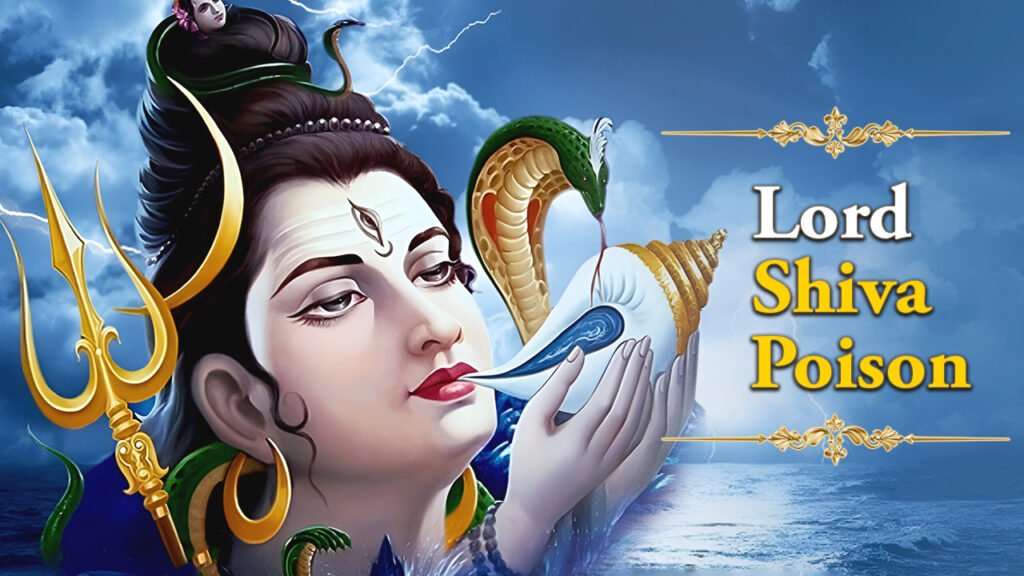Introduction to Lord Shiva Poison
In the vast tapestry of Hindu mythology, few stories are as captivating and profound as the tale of Lord Shiva Poison consuming the deadly Halahala poison. This extraordinary act of self-sacrifice has been etched into the annals of time, serving as a testament to Shiva’s boundless compassion and his role as the protector of the universe. But what exactly led to this dramatic event? Let’s dive deep into this fascinating myth and uncover the circumstances that caused Lord Shiva to take poison.
The Churning of the Ocean of Milk
The Devas and Asuras
Our story begins with a cosmic conflict between the Devas (gods) and Asuras (demons). These two factions, locked in an eternal struggle for supremacy, decided to join forces in a quest for immortality. Their plan? To churn the great Ocean of Milk, known as Kshira Sagara, to obtain the nectar of immortality, Amrita.
Mount Mandara and Vasuki
To accomplish this Herculean task, they uprooted Mount Mandara to use as a churning rod. But who would be strong enough to rotate such a massive object? Enter Vasuki, the king of serpents, who agreed to serve as the churning rope. The Devas took hold of Vasuki’s tail, while the Asuras grasped his head, ready to begin the great churning.
The process of churning
As they pulled back and forth, the mountain began to rotate, stirring the cosmic ocean. The friction was intense, causing the mountain to sink. To prevent this, Lord Vishnu incarnated as a giant tortoise, Kurma, providing a stable base for Mount Mandara to rest upon.
The Emergence of Halahala Poison
Nature of the poison
As the churning continued, something unexpected happened. Before the coveted Amrita appeared, a terrifying substance emerged from the depths of the ocean – the Halahala poison. This wasn’t just any ordinary poison; it was the most potent and deadly venom in existence.
Threat to all creation
The emergence of Halahala posed an immediate threat to all creation. Its fumes alone were powerful enough to destroy everything in its path. The Devas and Asuras alike were paralyzed with fear, realizing that their actions had unleashed a force that could annihilate the entire universe.
Lord Shiva’s Intervention
The plea for help
In their desperation, the Devas and Asuras turned to the supreme beings for help. They approached Lord Vishnu, who directed them to seek the aid of Lord Shiva, the destroyer of evil and the protector of the universe.
Shiva’s decision to consume the poison
When approached, Lord Shiva Poison immediately understood the gravity of the situation. Without hesitation, he decided to consume the Halahala poison himself. This selfless act was not just about saving the immediate participants of the churning, but about preserving the balance of the entire cosmos.
The Act of Consuming Halahala
Shiva’s method of drinking the poison
Lord Shiva Poison cupped his hands and gathered the deadly Halahala. However, he didn’t swallow it immediately. Aware of its potency, he held it in his throat, refusing to let it enter his stomach where it could wreak havoc on his body.
The blue throat (Neelakantha)
As Shiva held the poison in his throat, a remarkable transformation occurred. The potent venom turned his throat blue, earning him the epithet “Neelakantha,” which means “the one with a blue throat” in Sanskrit. This blue mark became a distinctive feature of Lord Shiva, symbolizing his sacrifice for the greater good.
Consequences of Shiva’s Actions
Saving the universe
By consuming the Halahala poison, Lord Shiva Poison effectively saved the universe from destruction. His act allowed the churning of the ocean to continue, eventually leading to the emergence of Amrita and other divine treasures.
Symbolism of the blue throat
The blue throat of Lord Shiva Poison is not just a physical attribute but a powerful symbol. It represents the retention of negativity and harmful influences, preventing them from spreading and causing destruction. It’s a reminder of the importance of absorbing and neutralizing negative energies for the benefit of others.
Other Treasures from the Churning
While the emergence of Halahala was a critical moment, it wasn’t the end of the story. The churning of the ocean produced several other divine objects and beings, including the wish-fulfilling cow Kamadhenu, the goddess of wealth Lakshmi, and finally, the nectar of immortality, Amrita.
Lessons from the Myth
Selflessness and sacrifice
The story of Shiva drinking the poison teaches us about the power of selflessness and sacrifice. It shows that sometimes, we must be willing to take on burdens for the greater good, even at personal cost.
Balance in the universe
This myth also illustrates the delicate balance of the universe. The churning produced both poison and nectar, representing the duality of existence. Shiva’s act maintained this balance, preventing the forces of destruction from overwhelming creation.
Cultural Impact of the Story
In art and literature
The image of Neelakantha Shiva has been a popular subject in Hindu art for centuries. From ancient temple carvings to modern paintings, this powerful symbol continues to inspire artists. The story has also been retold countless times in literature, each rendition adding new layers of meaning and interpretation.
In spiritual practices
Many spiritual practices and rituals are centered around this story. Some devotees of Shiva consume small amounts of poison (under strict supervision) as part of their worship, symbolically reenacting Shiva’s great sacrifice.
Conclusion
The story of Lord Shiva Poison taking poison is a profound tale of sacrifice, duty, and cosmic balance. It reminds us that even in the face of overwhelming adversity, there is always hope. Shiva’s act of consuming the Halahala poison was born out of necessity – to save the universe from destruction. But it also serves as a powerful metaphor for absorbing and neutralizing negativity, a lesson that remains relevant in our lives today.
Read Also: The effect Remedies and Benefits of Shankhpal Kaal Sarp Dosh
As we reflect on this ancient myth, we’re reminded of the potential for greatness that lies within each of us. While we may not be called upon to save the universe, we all have the capacity to make sacrifices for the greater good, to stand firm in the face of adversity, and to transform potential disasters into opportunities for growth and enlightenment.
For interesting astrology-related videos, subscribe to us on YouTube
FAQs
- Why couldn’t other gods consume the Halahala poison?Lord Shiva, being the destroyer in the Hindu trinity, was uniquely equipped to handle such a potent force of destruction. Other gods lacked this specific attribute.
- Did consuming the poison have any lasting effects on Lord Shiva?Apart from the blue discoloration of his throat, which became a permanent feature, the myth doesn’t mention any other lasting effects on Shiva.
- Is there any scientific basis for the blue throat phenomenon?While the story is mythological, some scholars draw parallels between the blue throat and the practice of certain ascetics who use herbs that can cause discoloration of the skin.
- Why is this story significant in Hindu culture?This story exemplifies the selfless nature of the divine and serves as a powerful metaphor for dealing with negativity in life.
- Are there any festivals or rituals associated with this myth?Yes, the festival of Maha Shivaratri often includes retellings of this story, and some devotees symbolically offer blue-colored items to Shiva in remembrance of his sacrifice.

